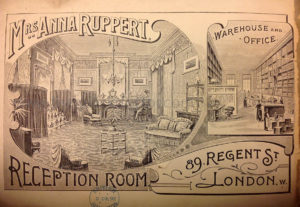
Source: The General Advertiser, 6 March 1744. Click here for transcript.
I wonder if this advert looks familiar to regular readers. The writing style and capitalisation, and even the medicine’s name, are reminiscent of Mr. Burchell’s Famous Little Sugar Plums, and here again we see a proprietor tempting punters with freebies. Dr Russel of the Green Hatch, Holborn, sought to tap into Burchell’s success by adopting the same tactics, but over the years it isn’t a clear-cut case of him copying his contemporary – they used lots of similar ploys and it’s not always obvious who got there first.
Ads for The Montpellier Little Bolus and Burchell’s ads for his Anodyne Necklace appear in the same papers, sometimes right next to each other. As I mentioned in the Sugar Plums post, Burchell gave away free almanacks – so did Russel, whose publication was called the Thee and Thou Almanack. The adverts say it offered answers to common questions about Quakers:
Why we are called QUAKERS?
Why we’ve Silent Meetings? Why Women Preach as well as Men?
Why we use THEE and THOU? Why we never Put off our Hats?
Russel also resorted to poetry:
This ALMANACK has Nothing Writ twice o’er
What’s in’t, No ALMANACK e’er had Before :
It is quite NEW, Year Thirty-EIGHT its Date is,
‘Twill Nothing Cost, for Thee may’st have it GRATIS,
At the Green Hatch, ‘gainst Gray’s Inn Gate in Holborn,
If to ASK for’t, Thee will not be too Stubborn.
(both bits quoted from the London Daily Advertiser, Feb 4 1737)
My favourite aspect of the ad at the top is that it offers a free dose to anyone whose name appears in the Venereal and Gleet Patient’s Directory.
‘Gleet’ (the word derives from the Middle English for slimy, and is related to the Latin gluten, meaning glue) refers in this context to a mucopurulent discharge from the urethra or vagina as a result of gonorrhoea. It lingered after the acute symptoms had subsided, and although clearly the result of the clap, was viewed as a condition in its own right. It is described as follows by William Buchan:
…when the quantity of running is considerably lessened, without any pain or swelling in the groin or testicle supervening; when the patient is free from involuntary erections; and lastly, when the running becomes pale, whitish, thick, void of ill smell, and tenacious or ropy ; when all or most of these symptoms appear, the gonorrhoea is arrived at its last stage, and we may gradually proceed to treat it as a gleet with astringent and agglutinating medicines.
Such astringent medicines included white vitriol (zinc sulphate) and preparations of lead injected up the affected parts. The great John Hunter wasn’t overly enthusiastic about astringents – he advised that introducing a simple, unmedicated bougie (a slender instrument) into the urethra would be enough to cure most gleets (in men, that is – he dismisses women’s gleets in a couple of paragraphs). The bougie ‘need only be five or six inches long‘ and required ‘a month or six weeks application.’ Hunter also mentions gleets cured by electricity, but does not specify how the cure was carried out.
For people putting up with this nagging condition, and faced with a variety of embarrassing and eye-watering cures, quack pills were worth a try, but the real genius of Russel’s modus operandi lies in the free pamphlet. The mid-18th-century sufferer was not expected to be loyal to a specific doctor and to blindly accept whatever he advised, so the average individual with a gleet might well have done the rounds of several practitioners and nostrum vendors. The idea that somewhere along the way you’d got on a published list of venereal patients was rather alarming.
Whether Russel’s directory contained real names or made-up ones, I don’t know, but once people arrived at the Green Hatch for a furtive shuffle through the pages, they were a captive audience for the Montpellier Little Bolus at 2s. a pop.



gleet – wonderful new word; i shall be gleeting frequently for the next few days until i find a curative pea-sized bolus
It is a great word – should be brought back into use.
That is fascinating (and terrible!) to think that there was an actual directory of venereal patients! So much for physicians and confidentiality. I wonder if it survives anywhere?
Terrific and fascinating post, as always.
I don’t know if there are any surviving copies but I am pretty sure it would have been fake – just a ploy to get punters in. The ads claimed it also gave advice to patients on how to find a cure but I’d imagine that when people went to collect it they’d discover it was just an insubstantial advertising pamphlet.
As a Victorianist, I’m interested that the ad is so forthright. It basically just says ‘this is for venereal disease’ rather than engaging in all the euphemistic subterfuge of such ads in later years. Certainly bears out the fact that frankness on bodily matters was more possible before the Victorian era.
Hi Melissa, apologies that your comment disappeared for a while after my site went offline yesterday.
Some other 18thC adverts are even more forthright, using the terms ‘the pox’ and ‘the clap.’ Although these were also referred to as ‘the secret disease’, the advertisers do seem to have been fairly realistic about it.